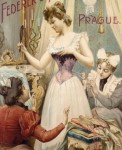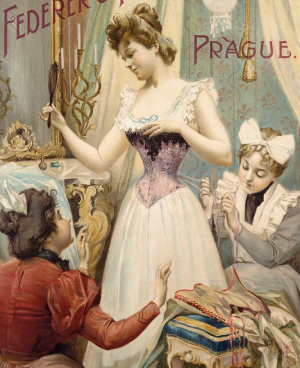
 Fabrique de corsets, Feder et Piesen, 1899.Devised to control the female body, the corset has had, between the 18th and the 20th century, many detractors.
Fabrique de corsets, Feder et Piesen, 1899.Devised to control the female body, the corset has had, between the 18th and the 20th century, many detractors.
In broad usage between the 16th and the 20th century, the corset is an under garment essentially conceived for women (but also worn by men). It is made in a stretchable, flexible material stiffened with stays and fastened by a lacing system set in the front or back according to fashion. This item, which would undergo many modifications over the centuries, be it in shape or in fabric, is intended to sculpt the female shape and straighten the body.
From the 16th century onwards, corset wearing was a social norm: for instance, children were fitted with a corset to learn proper posture. The corset taught the body. After the French Revolution, this specialisation became the preserve of medical corsetry; the undergarment became a prerequisite to women’s attire, whereas men did not altogether subscribe to the corset for aesthetic purposes. Under the Restoration (1815-1830), the Ancien Régime female ideal was back in force: to be beautiful, a woman had to work at it and beauty was no longer to be judged by the comeliness of a face. The 19th century was the peak era of the corset. Under the Second Empire, the corset was kept reasonably comfortable, but fashion would change at the end of the 19th century, tightening the waist, as female slimness remained engraved in the social mindscape. The hourglass shape became the accepted norm: a long corset would hug the abdomen down to the groin, bringing out the bust and a narrow waist.
As a result of this trend, corset making, which had developed in the 18th century, flourished into an industry with a fast-growing production by the middle of the mid-19th century. By 1861, 1 200 000 corsets were sold every year in Paris. Right up to the Great War, magazines would continue to promote the hourglass silhouette; but women were breaking free from this constraint, gradually forsaking the corset. The bodice, no longer snug under the breasts, got laced slightly looser.
There is also an erotic dimension to the corset: narrowing the waist, showing off the hips and breasts, it is a seduction device. The garment encasing the woman’s body gets unlaced by the man. In the process, the man possesses some kind of erotic power echoing the act of defloration. This symbolic still plays out today in the act of unfastening. This theme is developed in Louise de Vilmorin’s 1945 poem Le Corset: “the corset is […] the stronghold and the casket where your desires fleet in and out.”
Throughout the ages, the corset accrued numerous criticisms, be they medical or political. Indeed, physicians were always concerned with the use of this implement they considered incompatible with a wholesome functioning of the body. At the end of the 18th century, the faux silhouette was pilloried by the medical profession and some philosophers, including Rousseau, citing humankind’s degeneration. At the turn of the 19th century, the Naturalists defined this notion as a natural negative deviation of the species. By the 1900s, opposition to the corset had become explicit: the piece was deemed harmful to health for it compressed the chest and the waist, endangering the lungs, the liver, and the heart.
Alongside this medical stance, a political and more feminist trend emerged in reaction to the increasingly stringent aesthetic expectations placed on women. In the 1880s a militant women’s movement rejected the corset; activists joined forces with physicians and politicians to get press coverage, finding, in due course, an unexpected advocate in Paul Poiret a couturier at war with the garment. Indeed, by the early 20th century, women had had enough of the corset that excluded them from some activities. In 1906 women amounted to 40% of office workers; their work was incompatible with a braced body. Oppositions converged: an international trend for “Women’s Dress Reform” brought together several women’s associations that vaunted women’s natural beauty. In 1908, 20 000 leaflets against corset-wearing were handed out in Paris. Coco Chanel would in her turn illustrate how to dress “an active woman needing to feel comfortable in her clothes”.
Militancy thus heralded the end of corset-wearing. During WWI, the corset was loosened, then replaced by the brassiere. After the Great War, women wore a girdle instead, as the corset had been incompatible with work on the home front. The 20s boyish look confirmed the mutation: jazz age women were drawn to activities requiring a greater freedom of movement. Women have remained slight but slenderer; it is as though they had grown taller. Beyond the 30s, attention had focussed on the bust; the move to the bra would turn the corset into a fading memory.
Read more in the dictionary : Christine Jorgensen
Read the paper in French : corset
Références :
James LAVER, Histoire de la mode et du costume. Paris, Editions Thames & Hudson, coll. Univers De L’art, 2004.
Georges VIGARELLO, Le corps redressé, Paris, Armand Colin, coll. Dynamiques, 2001.
To quote this paper : Elisa Vaz, “The Corset” in Hervé Guillemain (ed.), DicoPolHiS, Le Mans Université, 2022.